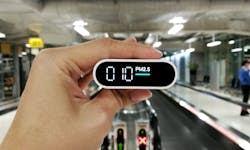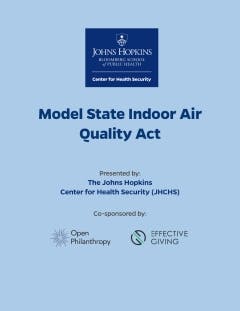Model State Indoor Air Quality Act Proposed
Open any weather report for your area, and in addition to temperature and humidity levels, you’ll also find the current outdoor air quality. But what about when you enter a school, an office building, a hospital, or a grocery store?
How do you know what that building’s air quality is?
The air we breathe directly impacts our health and well-being. While air quality outdoors is monitored and regulated by the federal government, that’s not the case indoors—where the average American spends at least 90% of their time.
Experts from the Johns Hopkins Center for Health Security are calling on states to create legislation aimed at improving indoor air quality in public spaces—and giving them the tools to do so through the new Model State Indoor Air Quality Act, published Aug. 17.
What’s contaminating our indoor air?
Many infectious diseases, including COVID, flu, RSV, and measles, spread through airborne transmission, which occurs much more easily in indoor environments.
“But there are a lot of other things that are in the air too, that are really unhealthy for you,” explains Gigi Gronvall, PhD, an associate professor of Environmental Health and Engineering and a senior scholar at the Center for Health Security.
Indoor air quality can be polluted by a range of sources, including mold, radon, carbon dioxide, particulate matter, chemicals in cleaning products, off-gassing from building materials and furnishings, and even outdoor air pollution. In fact, the concentration of some pollutants indoors is two to five times higher than outdoors.
How the air we breathe can help or harm us
The pandemic made clear the role of ventilated, clean air in preventing the spread of COVID, and research shows that improved air filtration and ventilation can also increase employee performance and productivity as well as improve test scores and teacher retention rates.
Repeated exposure to poor indoor air quality (IAQ), on the other hand, has been proven to:
- Lead to respiratory diseases, heart disease, and cancer;
- Exacerbate asthma symptoms;
- Increase student and teacher absenteeism, disrupting the learning process and student performance.
“It's not something we should be ignoring,” says Gronvall. “If you breathe poor air, you're not going to do as well, you're not going to think as well.”
What states can do
The Model State Indoor Air Quality Act (MSIAQA) was developed by the Center for Health Security in partnership with legal experts. It provides a legal framework for states and localities to implement legislation that will result in improved IAQ in public buildings by:
- Setting up state advisory councils to set standards appropriate for states’ needs.
- Requiring that indoor air quality be measured and the results posted publicly.
- Setting up a system for people to report health impacts potentially caused by bad air and for the state to investigate these reports and order necessary fixes.
It outlines best practices for how state and local governments can:
- Make sure legislation is actually enforced.
- Have authorities test IAQ and publish reports in buildings—not unlike restaurant health inspections.
- Educate the public about IAQ and the benefits of clean air.
- Allow experts to determine what levels of indoor pollution are and are not acceptable.
- Incentivize building owners to maintain clean air in their properties.
Why we need consistent regulation
While federal law regulates outdoor air pollution, “there is little federal legal support to protect peoples’ health through improved IAQ or to incentivize IAQ improvements,” reads the preface of the act. As a result, IAQ measures that have been put in place at the state, tribal, and local levels are not comprehensive or consistent.
“It’s really a patchwork,” says Gronvall, noting that some policies address only certain pollutants, like radon or secondhand smoke, or only certain spaces, like schools. The MSIAQA, she says, “offers a way to regulate more than just one thing or more than one environment.”
“Everyone deserves healthy indoor air,” says Paula Olsiewski, PhD, a contributing scholar at the Center for Health Security and co-lead of the Center's IAQ project team. “This model act gives states the tools to ensure that the air in public buildings is safe for people to breathe, whether the most urgent concern is airborne diseases, wildfire smoke, or asthma.”
What you can do right now
Individuals don’t need to wait for state or federal regulation to clean the air in their own spaces. A few simple changes can improve air quality in homes and offices:
- If your home has an HVAC system, installing a higher efficiency filter, such as a MERV 13, will greatly improve filtration;
- People whose homes use natural ventilation rather than central air conditioning can create DIY portable air cleaners simply by attaching a MERV 13 filter to a box fan made in 2012 or later (window units don’t work);
- Run a portable HEPA air cleaner continuously in a room where people are gathered to keep house guests or coworkers safer;
- Consider installing a carbon dioxide detector to make sure your home has optimal air ventilation.
##########
Aleyna Rentz is a marketing specialist for the Johns Hopkins Bloomberg School of Public Health. Aliza Rosen is a digital content strategist in the Office of External Affairs at the Johns Hopkins Bloomberg School of Public Health.

